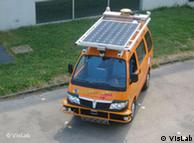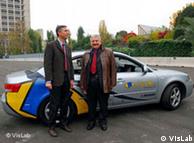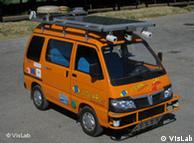TRANSPORTATION | 07.10.2010
Italian autonomous car trek makes final push into China
In July, an Italian company, VisLab, began a three-month, 13,000-kilometer journey from Parma, Italy to Shanghai, China. But it wasn't just any road trip. Their odyssey involves their autonomous vehicle, a bright orange van that drives itself along city streets and small highways while following another similar van as it moves through city streets and rural highways. The VisLab Intercontinental Autonomous Challenge is the longest and most difficult test of autonomous vehicles to date. Previously, many of the research team members had competed in a related autonomous driving competition held in California, which was sponsored by the United States Department of Defense.
In the third of a four-part interview series, Deutsche Welle spoke with the leader of VisLab, Alberto Broggi, who leads the project and is a professor of computer engineering at the University of Parma.
Deutsche Welle: Where is the vehicle right now?
Alberto Broggi: They are actually 500 kilometers (310 miles) into Kazakhstan. They had a little problem with visas. We are a little behind schedule because of that. The main problem was due to the fact that we had to pass customs from Russia into Kazakhstan [on September 29] and, unfortunately, there was a problem with our big on-board generator. The customs officials were not aware of that and we had some paperwork missing. So they sent [the team] to a different customs, which happened to be 1,500 kilometers away from that border. They had to go back, reach a different customs post and get out of Russia from there.
Now the vehicles are not moving automatically because that would take too much time. We loaded everything on the trucks and the expedition is moving manually.
So you're not driving autonomously, or automatically, for the rest of the trip?
We will reach Almaty and then from there onwards we will be driving autonomously. But not until Almaty.
Besides these border issues, have there been any technical issues in the rest of Russia?
Technically speaking there were no real problems. Everything was smooth. We were lucky that there was really nothing special in Siberia. Everything was flat and not much traffic, so it was an ideal situation. We've been looking for different situations - more challenging roads, and off-roads, in the western part of China.
 The van has seven cameras in total: five in the front and two in the back
The van has seven cameras in total: five in the front and two in the back
Did you encounter anything the car couldn't handle in these last parts of Russia? It sounds like it was pretty easy.
It was pretty easy, yes. There were just donkeys crossing the road, and cows on the road. But the system just detected them as obstacles, so that was not a big deal. That was the only big problem that I'm aware of. Everything was really, really smooth.
You have about a month to go. What's on deck for these last few weeks?
The main problem might be in the early days of October, let's say until the 10th or 12th of October. There might be some problems crossing the mountains and with bad roads. But once we pass that, I'm really anticipating a smooth drive until Shanghai. The road from Xi'an to Shanghai is really nice. We've been told that the roads are really nice, big roads, paved roads, and with nice lane markings. The real difficult part should be the first part, the first 10 days of October.
 Alberto Broggi (left) expects the vehicle to arrive on schedule on October 28 in Shanghai
Alberto Broggi (left) expects the vehicle to arrive on schedule on October 28 in Shanghai
Are there any big lessons that you've learned so far, or any big surprises after two months on the road?
I think I've already mentioned how in Moscow there was a big problem that actually opened up our mind to the problems of traffic in regions that are not respectful of the rules. This is something that we need to learn and study. But we will save that for the end. We just acquire images in that situation and in the end, we will study that problem. It's not just perception, we've been dealing with perceiving the road environments, obstacles, pedestrians and vehicles and whatever. In that case, it's not just perception, it's reasoning that is involved. We really need to figure out how to modify our driving patterns, which is completely different. It's a totally different level of abstraction. This is something that we will be studying when we get back.
Interview: Cyrus Farivar
Editor: Kate Bowen


No comments:
Post a Comment